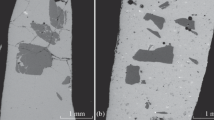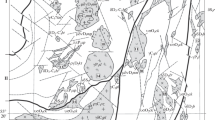Abstract—
New data were obtained on the chemical composition of beryl from the Suprunovskoye deposit (wt %): 66.10 SiO2, 0.51 Na2O, 17.99 Al2O3, 0.37 MgO, 0.03 K2O, 0.02 CaO, 0.58 FeO, and 13.70 BeO (calculated). Fluid and melt inclusions were investigated for the first time in this mineral. It was found that the beryl was formed during late stages of granite magmatism from a specific pegmatite silicate melt or a water–silicate liquid enriched in water (>7 wt %), heavy REE (La/Yb = 0.48), and lithium, and depleted in fluorine and boron at a temperature of ~700°C and a pressure of ~6 kbar.



Similar content being viewed by others
REFERENCES
Geology of the USSR. Volume 17. Irkutsk Oblast. Geological Description (Gos. Nauchn-Tekhn. Izd-vo po Geol. Okhr. Nedr, Moscow, 1962) [in Russian]
R. M. Hazen, R. C. Ewing, and D. A. Sverjensky, “Evolution of uranium and thorium minerals,” Am. Mineral. 94 (10), 1293–1311 (2009).
P. D. Ihinger, Y. Zhang, and E. M. Stolper, “The speciation of dissolved water in rhyolitic melt— preliminary results,” Geochim. Cosmochim. Acta 63 (21), 3567–3578 (1999).
E. Ya. Kievlenko, Gem Geology (Ekost, Moscow, 2001) [in Russian].
A. M. Mazukabzov, D. P. Gladkochub, T. V. Donskaya, A. M. Stanevich, A. N. Didenko, E. V. Bibikova, V. Yu. Vodovozov, A. A. Kazansky, T. I. Kirnozova, I. K. Kozakov, K. M. Konstantinov, B. B. Kochnev, D. V. Metelkin, T. Ota, V. K. Nemerov, A. A. Postnikov, et al., Precambrian Evolution of the Southern Siberian Craton (SO RAN, Nauka, 2006) [in Russian].
V. B. Naumov, “Thermometric study of melt inclusions in quartz phenocrysts from quartz porphyry,” Geokhimiya, No. 4, 494–498 (1969).
C. H. Nielsen and H. Sigurdson, “Quantitative methods for electron microprobe analysis of sodium in natural and synthetic glasses,” Am. Mineral. 66, 547–552 (1981).
A. A. Nosova, L. V. Sazonova, V. V. Narkisova, and S. G. Simakin, “Minor elements in clinopyroxene from Paleozoic volcanics of the Tagil island arc in the Central Urals,” Geochem. Int. 40 (3), 219–235 (2002).
I. S. Peretyazhko, V. Y. Zagorsky, S. Z. Smirnov, and M. Y. Mikhailov, “Conditions of pocket formation in the Oktyabrskaya tourmaline-rich gem pegmatite (the Malkhan field, Central Transbaikalia, Russia),” Chem. Geol. 210 (2), 91–111 (2004).
M. V. Portnyagin, S. G. Simakin, and A. V. Sobolev, “Fluorine in primitive magmas of the Troodos Ophiolite Complex, Cyprus: analytical methods and main results,” Geochem. Int. 40 (7), 625–632 (2002).
S. Z. Smirnov, “The fluid regime of crystallization of water-saturated granitic and pegmatitic magmas: a physicochemical analysis,” Russ. Geol. Geophys. 56 (9), 1292–1307 (2015).
S. Z. Smirnov, V. G. Thomas, V. S. Kamenetsky, O. A. Kozmenko, and R. R. Lager, “Hydrosilicate liquids in the system Na2O–SiO2–H2O with NaF, NaCl and Ta: Evaluation of their role in ore and mineral formation at high T and P,” Petrology 20 (3), 271–285 (2012).
R. Thomas and P. Davidson, “Hambergite-rich melt inclusions in morganite crystals from the Muiane pegmatite, Mozambique and some remarks on the paragenesis of hambergite,” Mineral. Petrol. 100 (3), 227–239 (2010).
R. Thomas, J. D. Webster, and W. Heinrich, “Melt inclusions in pegmatitic quartz: complete miscibility between silicate melts and hydrous fluids at low pressure,” Contrib. Mineral. Petrol. 139, 394–401 (2000).
R. Thomas, P. Davidson, and E. V. Badanina, “A melt and fluid inclusion assemblage in beryl from pegmatite in the Orlovka amazonite granite, East Transbaikalia, Russia: Implications for pegmatite-forming melt systems,” Mineral. Petrol. 96 (3), 129–140 (2009).
V. G. Thomas, S. Z. Smirnov, O. A. Kozmenko, V. A. Drebushchak, and V. S. Kamenetsky, “Formation and properties of hydrosilicate liquids in the systems Na2O–Al2O3–SiO2–H2O and granite–Na2O–SiO2–H2O at 600oC and 1.5 kbar,” Petrology 22 (3), 293–309 (2014).
V. E. Zagorsky, I. S. Peretyazhko, and B. M. Shmakin, Granite Pegmatites. Volume 3. Miarolitic Pegmatites (Novosibirsk, Nauka, 1999) [in Russian].
ACKNOWLEDGMENTS
We are grateful to academician L.N. Kogarko for useful consultations and N.V. Sorokhtina for cooperation.
Funding
This study was supported in part by Research Program no. 0330-2014-0005 of the Sobolev Institute of Geology and Mineralogy, Russian Academy of Sciences.
Author information
Authors and Affiliations
Corresponding authors
Additional information
Translated by A. Girnis
Rights and permissions
About this article
Cite this article
Gerasimova, E.I., Prokof’iev, V.Y., Smirnov, S.Z. et al. High-Temperature Beryl from Vugless Granite Pegmatites of the Suprunovskoye Deposit, Irkutsk Oblast, Russia. Geochem. Int. 57, 829–834 (2019). https://doi.org/10.1134/S001670291907005X
Received:
Revised:
Accepted:
Published:
Issue Date:
DOI: https://doi.org/10.1134/S001670291907005X




